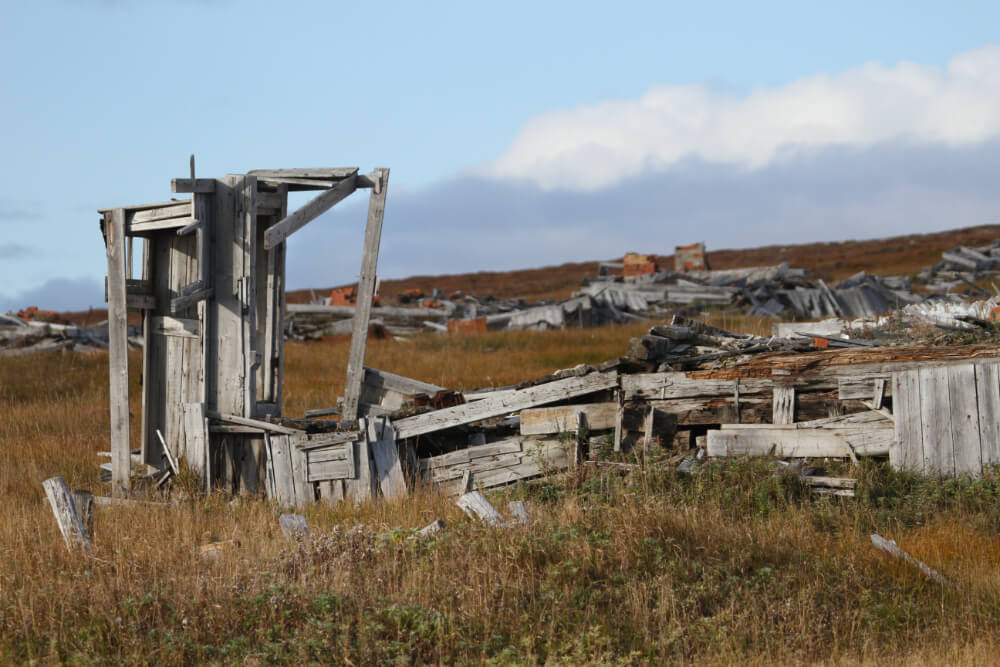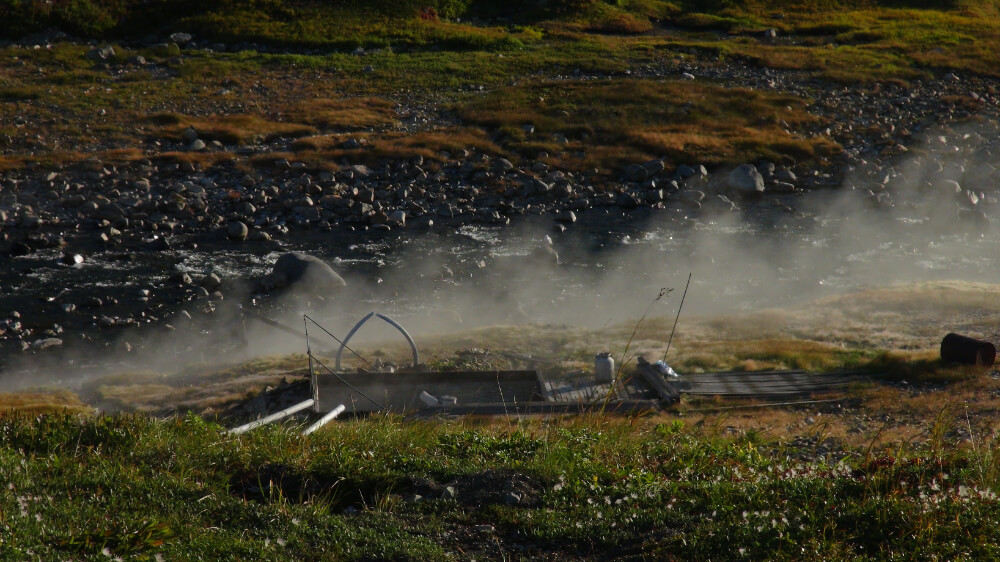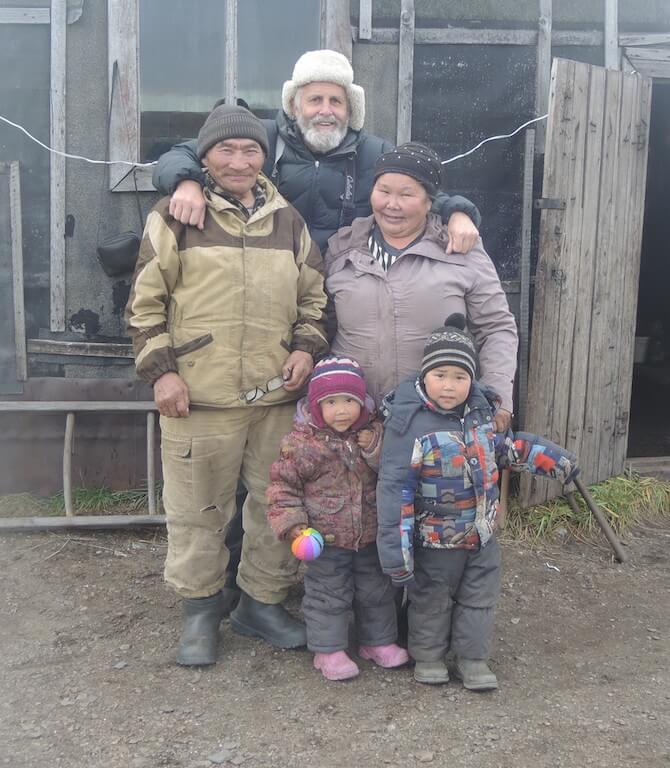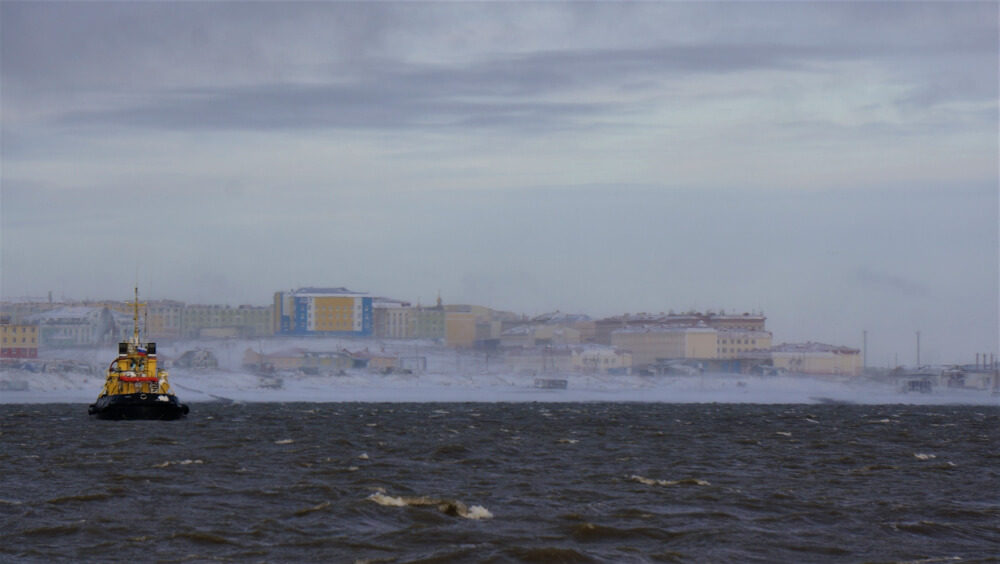As we departed Anadyr, the eastern most town in Russia, we started our journey into the deep north proper.
To Russia with Love Part 3
In Part 3 on the voyage of the MV Strannik, Rodney Russ takes us further up the coast of Russia, from Anadyr into some of the most inhospitable, yet stunningly beautiful regions of Northern Russia.
As we departed Anadyr we started our journey into the deep north proper. Our first port of call was Egvekinot on the shores of Kresta Bay just a few miles south of the Arctic Circle. The township was founded in 1946 as a Gulag, the political prisoners were set to work building a road to a tin mine at Lultin some 120 miles inland. Today Egvekinot is an important road head for several gold mines operating in the region and is also a staging point for the winter conveys (trucks) which supply the numerous small settlements along the north coast of Chukotka via a network of winter roads.
In Kresta Bay we encountered a large pod of Humpback Whales. Our interpreter Olga was studying this species and so we spent some time amongst them for her to get photographs that would allow her to identify individuals. On our arrival at Egvekinot, the Border Guards checked our papers before we were allowed ashore. The town has one of the best museums in Chukotka and so we visited here and soaked in the history.
Leaving Kresta Bay behind we headed southeast towards Komsol’skaya Bay and the town of Provideniya. Provideniya was a former Soviet Military Port and the eastern terminus of the Northern Sea Route or NE Passage. The town has experienced massive depopulation since Perestroika, the population has dropped from 6600 to about 1800. During the Soviet period, large conveys of ships or caravans as they were referred to congregated here before being assisted by icebreakers across the top of Russia to Murmansk. These caravans were the lifeblood of the Russian Far East. Today the Northern Sea Route administration keeps icebreakers on station along the route to assist any shipping that might require it.

BORDER ISSUES
Because of its proximity to Alaska, the town is an important Border Guard base and they (6 of them) were our first visitors after we dropped anchor. They wanted to check all our Border Crossings against our permit, their records and our logbook/charts. There was one small mistake that threatened to derail our plans. I had inadvertently transposed some figures for one of our earlier crossings putting us a few miles inland on the tundra Olga worked overtime to try and explain this was a simple typo, but Border Guards are trained not to trust anybody. They eventually agreed to call it an administrative error and we parted friends.
Providenyia is also headquarters for the recently formed Beringia National Park. This park includes large areas of Northern Chukotka and has some unique issues. Firstly the boundaries are discontinuous as a result of trying to take into account natural history values and traditional land use and secondly it includes control over some sea areas to protect marine mammals such as walrus, seal, gray and bowhead whales which are also hunted by the indigenous Chukchi and Eskimo peoples. We spent a leisurely afternoon around a fire with friends who work for the Park.
The weather map for the next few days looked good for a run through the Bering Strait so we farewelled Providenyia and headed north towards the islands in the Senyavina Strait and the famed whalebone alley on Yttygan Island. Whale Bone ally is an archaeological site, the age and function of which is debated by scholars. The consensus is that it dates from the 14th century and is either an important ceremonial site or a communal butchering and meat storage site. Whichever one of these it is still impressive. You can walk down an alley of gray whale jawbone to some platform areas constructed from the local rock. Numerous Gray whale skulls also adorned the site.

THERMAL POOLS
One last stop before we continued north, the Gilmimyl thermal pool. It is not what you imagine hot pools to be, but they are one of my favourite sites in Chukotka. They are a simple wooden lined pool perhaps 2.5m x 1.8m beside a river in the middle of high arctic tundra. As they say, it is all about location location location and I agree. We soaked in the pool, plunged into the ice-cold river occasionally and literally chewed the fat with local Chukchi many of whom I knew from previous visits.
We worked our way slowly north along the western shoreline of the Bering Strait anchoring in the Mechigmenskiy lagoon with the intention of visiting the ancient and now abandoned Eskimo village of Mechigmen. The weather changed while we were here and we ended up spending a couple of nights. We were visited by some local Chukchi Reindeers herders who generously shared some of their fresh reindeer meat with us. The next stop was the village of Lavrentiya. It is on the southern shores of Lavrentiya Bay, named by Cooks 3rd Expedition as they arrived here on the feast day of St Lawrence in 1778. Lavrentiya is the administrative centre for this region, it also frequently hosts the annual Beringia Arctic games where teams from Chukotka, St Lawrence Island and Alaska compete in traditional games such as wrestling, bardara (traditional walrus skin covered boats) racing and dancing. It also hosts the Nadezhda dog sledding race, Chukotka’s equivalent of the Iditarod. I had attended both the games and the race on previous occasions and knew many of the people in the village. Before we could land though the Border Guards checked and double-checked our papers.
The hospitality was genuine and it was tempting to stay but I wanted to visit the nearby abandoned village of Nunyamo. It is one of several Eskimo villages that the Soviet Government had forcibly closed and relocated in the 1950s. One of the more infamous ones was the village of Nauken perched on the hillside near Cape Dezhnev. The argument for relocating the villages was that they were too difficult to administer and service, the reality was that they were a perceived security risk being so close to Alaska. We wandered around the remains of Nunyamo and tried to imagine what life would have been like for these people.

Back on board, we laid a course for Cape Dezhnev and the Bering Strait proper. Cook named the Bering Strait after Vitus Bering in the mistaken belief that he was the first European to transit the Strait on his 1728 expedition. However, the honour of being the first European to transit the Strait belongs to Semyon Dezhnev, a Cossack who had sailed east along the north coast of Russia from the Kolyma River in 1648. There is a monument to Dezhnev near the lighthouse on the Cape that bears his name.
The Border Guards stationed on nearby Ratmanov (Big Diomede) Island called us as we passed out of the strait. This island is the easternmost possession of the Russian Federation and the closest territory to the USA. The only inhabitants are Border Guards and military personal. It is just 2 nm across the dateline to Little Diomede Island which is claimed and manned by American personal from similar agencies.
We turned west and followed the northern coast of Russia, we were close enough inshore to see the villages of Uelen, Inchoun, Emnytagyn, Enurmino and Neshkan. I had snowmobiled along this coast in the winter of 2017 and met many of the folk that lived in these villages. They were predominantly marine mammal hunters or reindeer herders. They are hospitable and very generous people and I was disappointed we didn’t have time to stop but we had agreed to be at Wrangel Island by a certain date and we still had 360 miles to go. However, there was one stop that I just had to make and that was at Kamakai in Kolyuchinskaya Bay. Just before the entrance to the Bay, we passed the point where the Swedish explorer Nordenskjold had wintered over during the first every transit of the NE Passage in 1878. Ice had stopped him just a few miles short of his goal and forced him to spend a winter here. How different conditions were today there was no ice for hundreds of miles according to the ice maps we had downloaded

Kamakai is not a village, it is just a single very simple hut where two very dear friends Vasili and Galina live. They were reindeer herders who have retired here and live the simplest of lives on the tundra. We had stayed with them on our snowmobile trip in 2017 and had made lifelong friends. We took fresh food and some special treats for their grandchildren who were living with them and spent an enjoyable couple of hours. Their closest neighbours are some 60 miles away at the village of Neskan. They keep in contact with their reindeer herding family by radio.
WRANGEL ISLAND
We said our farewells not sure when we would see them again and sailed back to the open sea, from there we had 250nm to Wrangel Island. Our course took south of Kolyuchin Island. On the western end of the island, we could just make out the remains of an abandoned Metrological and Research Station. It was one of over 100 stations built and manned by the Soviets to provide data and information for the caravans transiting the NE Passage. The majority are now derelict.
We enjoyed a good run to Wrangel Island and arrived at 0800 on the 24th of September. The Island is a Federal Nature Reserve. The Islands existence was speculated upon by the explorer Von Wrangel in 1764 after he saw birds flying north from the Russian mainland. The island was named after him when the Island was eventually discovered in 1867. An archaeological site was discovered on the island which suggests that Paleo Eskimos had at least visited the Island before European discovery. Russia formally claimed the Island in 1924. Although that didn’t stop both Canada and USA from making claims.

The island is probably best known as a breeding ground for Polar Bears, it is often referred to as the Polar Bear maternity ward. As the climate warms and the sea ice recedes further and further north each summer, more and more polar bears are forced to seek refuge here. (In 2017 we counted 158 polar bears feeding on a dead bowhead whale.) Muskox from Canada were liberated onto the island in 1975 and progeny from this herd have recently been taken to central Siberia in an attempt to re-establish a Siberian herd as they had become extinct there. Snow geese breed here and migrate to North America in the winter. Arctic foxes and wolves roam the Island and a remnant population of reindeer exists, albeit in very small numbers. Reindeer along with Reindeer Herders were brought to the Island in 1926 as part of the Russian claim. We landed at the old village of Somnitelnaya in Krasin Bay where the Reindeer Herders once lived. Their houses are delict but the Nature Reserve maintains a summer base here and it was here we caught up with Alexander Gruzdev the Director of the Park and discussed our plans to pick up the film crew who were based at Draggi Bay on the eastern end of the Island.
The Island has always played an important strategic role for the Russian military. At the height of the cold war, the island was an important military base for both the air force and army. There are no natural or sheltered harbours on the island and as it was often icebound year around, it precluded the navy.

The Russian Federation has recently re-established a military base at Ushakovskiy in Rogers Inlet, this was a no-go zone and our permit stated we had to keep 12 miles off the coast when passing it which meant a significant detour moving from Kasin Bay to Draggi Bay.
Rogers Bay where the Military and the Park headquarters are is synonymous with one of the greatest Arctic shipwreck and survival stories. In 1914 the Karluk, (Capt. Bartlett) was crushed in the ice and sunk. The survivors struggled ashore across the ice and built a camp at Draggi Bay. The party was to split later and a second camp was established in Rogers Inlet. In the meantime, Bartlett and an Eskimo guide walked across the Long Strait to Chukotka eventually finding their way to Nome Alaska to get help for the crew. They were eventually rescued by a vessel called the “Wing and Ding”. The expedition organiser, who had abandoned Bartlett and the vessel when it first became trapped in ice off the Alaskan coast, Vilhjalmur Stefansson mounted a second expedition in 1921 to lay claim to the Island for Canada. A young Alaskan girl, Ada Blackjack (who had been employed as a seamstress on the Karluk Expedition) signed up for this ill-fated expedition. The stories of the Karluk Expedition and the second expedition are best told by Jennifer Niven in her books “The Ice Master” and “Ada Blackjack”

DRAGGI BAY
We arrived at Draggi Bay at 1130 hrs and made radio contact with the film crew. The sea conditions were far from ideal for a pickup but the weather forecast wasn’t much better, so we choose a spot on the beach close to the Karluk monument where the surf seemed a little less wild. Two trips in the RIB with a mountain of gear and four people and the job was done. It was late in the season and with strong South Easterly winds forecast we decided to run for it, there had been talk of going via Herald Island a remote island some 35 miles east of Wrangel Island but that idea was soon dropped in favour of heading to Anadyr.
The first 24 hours of our run south were good but then 35-40kt headwinds (the southeasterly which had been forecast) came away. We opted to turn and run into Kolyuchinskaya Bay where we remained at anchor for 24 hours until the weather eased. We didn’t make any further stops until we got to Anadyr where the film crew disembarked. Autumn had definitely arrived, daylight hours were considerably shorter, snowstorms were frequent and chunks of ice were floating down the Anadyr River.

We took on stores and fuel and left for Petropavlovsk-Kamchatskiy sad, but glad to be leaving, in the knowledge that we would be back. We sheltered from the weather in Bukta Paval for a couple of days and also briefly at Karaginsky Island. The Border Guards continued to take an interest in us and kindly pointed out that our cruising permit had expired, which meant that we had to stay with 12nm of the coast, there was no cutting corners. Taking a risk that they wouldn’t see us wasn’t even a consideration because we knew Moscow was watching us.
On arrival in Petropavlovsk-Kamchatskiy on the 19th of October we had completed 4800nm in the two months we had been away. We stayed just long enough to complete departure formalities take on a few stores before leaving for Japan. Yokohama next (official) stop.




